
Fabric printing is the process of decorating textiles with attractive designs and patterns. Here’s a rundown of the most popular techniques for fabric printing.
The three most common textile printing techniques are:
Direct printing: in which the fabric’s surface is directly printed with dyes or pigments.
Discharge printing: is a method of removing specific colours from an already dyed fabric using the correct chemicals.
Resist-printing: this is a method that entails applying a special resist-paste to the cloth in patterns, then dyeing it so that the paste applied spots will resist the dye and look like the original colour. This is a form of fabric printing utilizing tie-dye and batik.
Fabric printing is done in a variety of distinct ways, each with its own set of procedures. Some key ones are listed below.
Fabric printing using roller-printed ink is known as rotogravure printing. It’s the method used to make most of the garments you buy in stores. The fabric is passed through design-engraved rollers in a printer, which applies dye to it and then spins it at high speed.
The main benefit of this printing technique is that the same high-quality print is produced equally across the whole batch. A distinct roller is used for each colour. To set the dye, after it has been printed, the fabric goes through a drying and steaming process.
With a single machine, you may print up to 120000 yards of fabric in a day, with any complex design that you desire with accuracy and perfection.
This sort of printing is often done with a chemical (liquid photo emulsion) that is sensitive to light and any picture may be added.
Blueprinting is a popular method for fabricating objects. Sir John Herschel invented this technique, which allows you to imprint most items on your pretreated cloth. White or light-coloured prints are produced on a blue background. You may discover more about blueprinted fabrics here.
Wood, metal, paper, or plastic stencils are used to create the designs. Metal, wood, paper, or plastic stencils are used to make them. The dye/colour is sprayed into the holes dug by the stencil. It’s a straightforward and rapid method of producing cloth that can be done by anybody. However, it is time-consuming and takes a long time to print. It’s primarily for one-time applications.
This is how you make woodblocks, copper plates, or other items with a design on them.
A design is carved into metal or wood blocks, and the carving is stained with dye. After that, it’s pressed and applied to the cloth’s surface.
For more information, see the post on DIY block printing. For ideas on how to create your own fabric stamps and block printing, check out the section on DIY block printing.
Layering is a technique of dye application that involves spraying the cloth with a liquid solution. To apply colour to fabric, use sprayers designed for controlled applications. The colour is forced through screens using a spray gun.